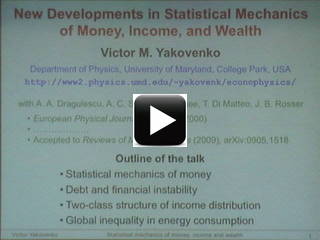The talk reviews progress in applications of statistical physics to
probability distributions of money, income, and wealth in a society.
Developing an analogy between the probability distributions of energy in
physics and money in economics, we argue that the distribution of money
should follow the exponential Boltzmann-Gibbs law for certain classes of
models with interacting economic agents. Analyzing the empirical data,
we found that income distribution in the USA has a well-defined
two-class structure. The majority of the population (about 97%) belongs
to the lower class characterized by the exponential ("thermal")
distribution. The upper class (about 3% of the population) has a Pareto
power-law ("superthermal") distribution, whose parameters change in time
with the rise and fall of financial markets. Recent studies, such as
the role of debt and the distribution of energy consumption around the
world, are discussed. For a review article, see
arXiv:0905.1518
submitted to Reviews of Modern Physics.
 Other video options
Other video options
To begin viewing slides, click on the first slide below. (Or, view as pdf.)
![[01]](tn/01.gif)
![[02]](tn/02.gif)
![[03]](tn/03.gif)
![[04]](tn/04.gif)
![[05]](tn/05.gif)
![[06]](tn/06.gif)
![[07]](tn/07.gif)
![[08]](tn/08.gif)
![[09]](tn/09.gif)
![[10]](tn/10.gif)
![[11]](tn/11.gif)
![[12]](tn/12.gif)
![[13]](tn/13.gif)
![[14]](tn/14.gif)
![[15]](tn/15.gif)
![[16]](tn/16.gif)
![[17]](tn/17.gif)
![[18]](tn/18.gif)
![[19]](tn/19.gif)
![[20]](tn/20.gif)
![[21]](tn/21.gif)
![[22]](tn/22.gif)
![[23]](tn/23.gif)